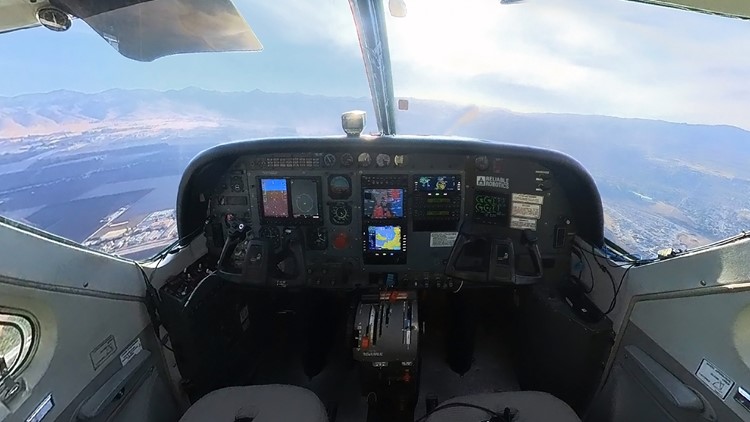HOLLISTER, Calif. — This past November, when most of us were getting ready for Thanksgiving, a man who grew up in Corvallis was in California preparing to take his place in aviation history. Robert Rose is the CEO and co-founder of Reliable Robotics, and a few weeks ago his company sent a plane on a test flight over Hollister, south of San Jose — with no pilot on board.
Drones have been flying unmanned for decades, but there are still remotely-connected pilots controlling the aircraft in real time. The Cessna 208 Caravan that took off at daybreak on Nov. 21 was different — it was flying all by itself using an autonomous designed by Reliable Robotics, with a remote pilot feeding in commands, but not direct control.
Fifty miles away in Mountain View, California, engineer and pilot Danah Tommalieh prepared to monitor the flight, watching as a another pilot inside the Cessna made preparations — then got out. It was a moment the company had sought for a long time, and one Tommalieh will remember a long time. “It was exciting.
Thankfully, I had a lot of training beforehand to prepare for the moment,” she said. “But the second the pilot stepped out, all that training kicking in and it went by super-fast, but it was truly an awesome moment. ” She directed the plane to the end of the runway using her computer, then watched it take off.
Cameras provided a stunning view from inside the cockpit, with no one at the controls and no one on board at all. “Oh yeah, this was a big moment,” Rose said. “We had done this before back in 2019 on a Cessna 172, so we had some idea what to expect.
But that aircraft is about one-third or one-fourth of the size of the Cessna Caravan. It’s a big step in terms of the organizational capability and the safety analysis that we needed to perform with this system. It was a really big day for us.
” The Cessna Caravan weighs about 3,000 pounds and can carry up to 12 people. They’re sometimes visible in the skies around Portland, and are often used by companies like FedEx to delivery packages. The size of the aircraft meant that the Federal Aviation Administration was keeping a much closer eye on the November test.
Rose grew up in Corvallis and is no stranger to technology, especially remotely-controlled and autonomous vehicle technology. He previously worked as a director of flight software at SpaceX, and led a team at Tesla that developed novel computer vision and human-machine interfaces and control technology. But equipping a plane to fly by itself comes with its own set of challenges.
“If you’re not going to have a pilot in the plane, well, step one, you need a plane that’s actually capable of managing itself through all phases of flight,” he said. Navigation is a big challenge in aircraft today, with the pilot expected to be constantly cross-checking instruments with one another, he explained. The GPS positioning readout, for example, has to be consistent with the airspeed, the Aircraft Communications Addressing and Reporting System and lots of other instruments.
“We don’t have that luxury if we don’t have the pilot inside the plane, so we need to add additional levels of redundancy and software to cross check all of those instruments to make sure that they can be trusted,” he said. “That’s complicated. ” Modern planes feature advanced autopilot systems that can be switched on during flights, and some airports are equipped with infrastructure that works with those autopilot systems to fully automate the landing process — but not many airports have that feature, and Hollister isn’t one of them.
Designing an onboard system that can land a plane all by itself at a regular airport was another enormous part of the challenge, Rose said. After a 12-minute flight, the Cessna successfully touched down again, and Tommalieh and the other crew members celebrated. It’s an important step, Rose said, but there’s still a long road ahead.
“I think it’s going to take many years before this technology is first certified by the FAA,” he said. “. .
. It’s hard to predict exactly when because when you’re doing, when you’re developing systems to this level of reliability, and you’re performing safety analysis to this level of detail, it’s hard to predict what you will encounter, and the work is done when it’s done. ” Rose said he optimistically hopes to see autonomous aircraft systems in regular use by the end of the decade, but however long it takes, he thinks it’ll be worth the wait.
“Autonomous aviation is going to change the world,” he said. “The jet age shrank the world, and much like the jet age, I think autonomous aircraft are going to enable a factor of 10, factor of 100 more aircraft to go into the sky, and that’s going to have implications on how people move and how we move goods around the planet, that I think is going to bring a lot more peace and prosperity to planet Earth. “.
From: kgw
URL: https://www.kgw.com/article/news/local/the-story/corvallis-man-helps-aviation-milestone-pilotless-jet/283-2b6678bf-621f-4b9a-ba5e-8330703d2c3f



